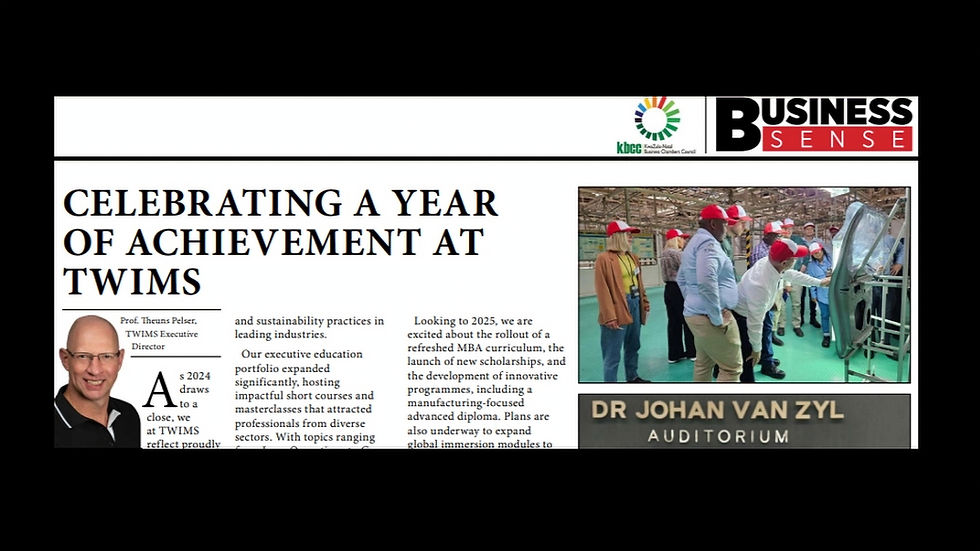TWIMS - Africa As A Place To Manufacture: Three Charts To Consider
- Grant

- Jul 1, 2022
- 4 min read
Updated: Sep 7, 2022
According to the OECD by the year 2040, 34% of youth (age 15-29) or 164 million young people in Africa will have at least an upper secondary or tertiary education. This positions the continent well towards being a manufacturing hub for goods for both domestic consumption and export. Join Mbongeni Ndlovu and guest lecture Glen Robbins on 2-4 August 2022 to learn more about the scope for manufacturing in Africa and how your business can expand its reach and secure this regional opportunity.
Many of us are familiar with the fact that the African continent’s share of global manufacturing value-added was reported as being only at 2 per cent in 2021 (UNIDO, 2021: 7). This stark fact goes a long way to explain the continent’s share of global Gross Domestic Product (GDP) being barely above 3 per cent (ibid.: 7). Two of the reasons for the continent’s weak position in global manufacturing in the past have been reported as the poor educational attainment of its workforce and infrastructure barriers to manufacturing firm operations. Many countries across the continent, South Africa included, have much work to do in these fields. However, the charts below paint a picture of steady improvements that will, in the next decade, see significant parts of the African continent reflecting educational attainment and technology infrastructure access levels not too dissimilar to those of many countries in the Asian region. Not only will this serve to boost productivity, but it will also help drive a growth in employment and in Africa as a market, not just for consumers, but also for producers wanting to take advantage of proximity to these markets as well as some of the unique capabilities that have already been seen in something like mobile money services.
Drawing on material from a 2021 African Union Commission (AUC) & Organisation for Economic Cooperation and Development (OECD) report on Africa’s Development Dynamics 2021 it can be seen in Figure 1 that persistently low educational attainment figures of the last century for much of the continent are a thing of the past. While challenges undoubtedly remain, over the next century, manufacturing businesses needing young, educated workers will increasingly need to look to the African continent. This data also bodes well for many other development concerns across the continent in that a better-educated population is likely to support improved services and infrastructure and also lead to demands for better governance.
Figure 1. Youth cohorts, aged 15‐29, by educational attainment in Africa and Asia according to business‐as‐usual scenarios, 2000‐40


(Source: AUC/OECD, 2021. Africa’s Development Dynamics 2021: Digital Transformation for Quality Jobs, AUC, Addis Ababa/OECD Publishing, Paris, https://doi.org/10.1787/0a5c9314-en.)
Alongside this, whilst many observers reported on Africa as a telecommunications desert in the 1980s and 1990s, the continent has in recent years seen some of the fastest growth in access to the internet and the adoption of mobile phone use – driven in part by the desire of people and institutions to overcome the gaps so evident in past infrastructure and services. Figure 2, also reported by the AUC/OECD (2021), indicates that people living across the continent are increasingly utilising the internet and related digital platforms and more and more are doing this using mobile telephones, including smartphones. This data talks to an increasingly informed and connected population where past barriers to both social and economic interactions are steadily being overcome, some might even say they are being leapfrogged.
Figure 2. Mobile phone and Internet usage among Africa’s youth, aged 15‐29, by geographical situation, gender, level of education and employment status, 2015‐18

(Source: AUC/OECD, 2021: 26)
What might this mean for firms operating in countries across the continent? A 2021 report by the United Nations Industrial Development Organisation (UNIDO) points out that these skill and technology capabilities are finding their way into both service and manufacturing companies. Whilst internet usage in business processes or having a business website might be seen by some as not counting for that much, as parts of the world embrace technologies of the so-called Fourth Industrial Revolution, this is a sign that existing firms across many countries are striving to connect themselves with these processes.
Figure 3. Formal manufacturing and service firms in Africa that use the Internet

(Source: UNIDO, 2021: 29)
Trends such as those noted above are key to decision-makers considering where their firms might be selling products in the near-future and where it might make sense to be producing these products. Participants in the TWIMS ESC on African Industrialisation will find themselves in a room with others in the manufacturing eco-system and get to participate in a process of sharing insights as well as engaging with knowledge from experts on different features of the African continent.
In the first week of August, TWIMS will be hosting an Executive Short Course on African Industrialisation. This course is geared at those working in and with the broader manufacturing eco-system who are eager to grapple with the challenges and opportunities of Africa’s industrialization path as the continent goes through processes of major economic and social transformations.
For further information on the African Industrialisation ESC click here or email info@twimsafrica.com.
Article By: Glen Robbins



